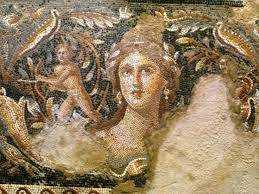Paganistan: Notes from the Secret Commonwealth
In Which One Midwest Man-in-Black Confers, Converses & Otherwise Hob-Nobs with his Fellow Hob-Men (& -Women) Concerning the Sundry Ways of the Famed but Ill-Starred Tribe of Witches.
Birth-Cave
It will come as no surprise to anyone likely to be reading this that Christendom's two most sacred shrines, those marking the supposed sites of Jesus' birth, death and burial, are both located on the sites of old pagan holy places.
In a spasm of triumphalist destruction, the emperor Constantine (of cursed memory) tore down Roman Jerusalem's major temple, the Temple of Venus, to build the Church of the Holy Sepulcher on its site. (According to Israeli novelist Meir Shalev, the original builders of the church simply paved over a mosaic of Venus in one corner; ever since, that section of the floor always feels hot to the touch.)
Same deal with Bethlehem's Church of the Nativity. In a letter dating from 395, Eusebius Sophronius Hieronymus (later known as “saint” Jerome), translator of the Vulgate (Latin) Bible, who had himself lived in Bethlehem for a number of years, writes: “Bethlehem...belonging now to us...was overshadowed by a grove of Tammuz, that is to say, Adonis, and in the cave where the infant Christ cried, the lover of Venus was lamented” (Taylor 96).
Tammuz' sacred grove, of course, is long since gone, but the birth-cave that still underlies the Church of the Nativity was mentioned by Christian writers as early as the second century. Jerome, in the late 4th century, is the first to mention the cave's previous divine tenant, admittedly a late attestation; but he seems unlikely simply to have invented a pagan origin for the site.
Even conservative Biblical critic Jesuit Raymond Brown readily admits in his magisterial study of the gospel birth-narratives that their historical value is virtually nil. (We don't even know for sure that Jesus was actually born in Bethlehem.) But by the late third century, Christian tourists were already coming to Bethlehem, asking to see where Jesus was born, and naturally the local tourist industry provided a venue. Where else but at the local holy place? (You know gods: they always hang out together.) That will be two sesterces, please.
Earth brings all things to birth, even gods. Think of Mithras' rock-birth. Zeus himself was born in a cave on Crete's horned Mount Ida, where he was fed on honey and goat's milk, and entertained by the dances of the youthful Kouretes. As the painters of Europe's painted caves knew well, the cave is the womb of the Earth.
![]()
The Eastern Orthodox icon of the Nativity shown above depicts, at center, a mountain with a cave, in which the Virgin Mary lies on a pallet; in the foreground, the midwife washes the newborn. The scene faithfully preserves the iconography of late Classical art: compare the 4th -century mosaic of the birth of Alexander the Great from Baalbeq.

And north of Bethlehem, the river Jordan still flows from a cave named for—and sacred to—Pan and the Nymphs.
What's a poor monotheist to do?
Our current Christmas customs come from Persia and from Greece,
from solstice celebrations of the ancient Middle East.
This whole damn Christmas schpiel is just another pagan feast.
O tidings of reason and fact, reason and fact,
glad tidings of reason and fact.
Christopher Raible,“God Rest You, Unitarians”
From: Songs for Cessation of Strife
Raymond E. Brown, The Birth of the Messiah (1977). Image.
Joan E. Taylor, Christians and the Holy Places: The Myth of Jewish-Christian Origins (1993). Oxford: Clarendon Press.
Above: Mona Lisa of Galilee
Roman mosaic (4th century), Sepphoris
Comments
-
Please login first in order for you to submit comments






















(You know gods: they always hang out together.) That brought to mind the Avengers and The Justice League, which in turn brought to mind an episode of South Park with the Super Best Friends: Jesus, Moses, Mohamed, Buddha, Joseph Smith, and Lao-Tsu.